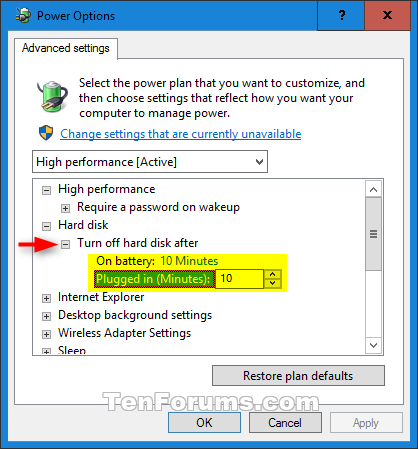When Plugged In Turn Off After
This policy setting specifies the period of inactivity before Windows turns off the hard disk.If you enable this policy setting you must provide a value in seconds indicating how much idle time should elapse before Windows turns off the hard disk.If you disable or do not configure this policy setting users can see and change this setting.
Appreciate all of the info. I'll see if I can't set Tasker up to turn off the device when the power is removed. If that doesn't work, I'll go build my own version of Android that changes the battery shut off percentage to something high enough to make sure it will turn on as soon as power is applied. Thanks again for all of the info! Dec 08, 2017 Question Laptop switches itself off after I turn it on, screen dead: Question Laptop screen turning on and off: Question Laptop turns on, shows the loading screen then screen goes black. Question Laptop turns off when unplugged, screen wont turn on when plugged with no battery: Question Laptop screen won't turn on only when plugged in. Surely by using smart surge protectors at every socket is just as bad for the enviroment as leaving the odd device plugged in on standby, its seems common sense that if there is a led, light or display that the device is using electricity, tv’s have a standby and an off so turn it off!! Using a timer is clearly going to use electricity as the.
Policy path:
Scope:
Supported on:
Registry settings:
Filename:
Ideally yes you should turn off certain appliances at the socket when not in use. If the wall socket doesn’t have an on off switch it would need to be unplugged instead.

Electricity still runs inside an appliance even if it’s switched off. If electricity is present, there is always the possibility of something overheating or shorting out. However, it is far more likely that if something was to go wrong it would be whilst the appliance is in use.
Where does electricity run inside an appliance?
With an appliance plugged into the wall socket electricity runs first through its plug and mains cable. After that it enters the appliance and goes through a mains filter (suppressor). Then on to the on off switch. Theoretically it should stop there until the on – off switch is activated. But it is possible for power to also go to the main PCB, the door lock, control panel.
In the past I’ve known mains suppressors on some washing machines short out and explode (like a firework – but no fire). The washing machines were not in use at the time. To be fair that was a long time ago and on a specific brand of washing machine. But this shows the possibility of something shorting out with the appliance not running.
Recent examples of fires with appliances not running
This article was inspired after reading a recent media article where a tumble dryer had apparently, “caught fire” whilst left plugged in. From the pictures that I could see though it appeared that the fire incident was small, and confined to the wall socket and plug. Someone also added a comment to one of my articles saying that their tumble dryer caught fire whilst left plugged in but not running.
Forbes rent appliances and specialise in renting Bosch appliances so they know them inside out. They also rent other brands and many other products – more details at Forbes
Peter Tyson Appliances are an Authorised Miele Dealer and give high quality service coupled with special offers and competitive prices.
Is it essential to turn off appliances at the socket?
This is what I do
My own washing machine and tumble dryer are in our garage. They are very much out of sight. We always try to remember to turn both of them off at the socket when we have finished using them. Fortunately, this is pretty easy as both sockets are easily accessible just above the appliances..
Our dishwasher on the other hand is a built-in appliance in our kitchen. The socket for the dishwasher is located behind a load of pots and pans in the bottom of a cupboard and behind a back panel. It is accessible, but only with a fair amount of effort. Therefore unfortunately we never turn it off at the socket.

When Plugged In Turn Off After Means
If we ever did have a fire we would no doubt seriously regret that. But as you can imagine it is a lot of extra messing about with an appliance that is used virtually every day. We all have to make these kind of judgement calls. The risk is not great, but is undeniably there.
When Plugged In Turn Off After
So if it is easy to turn off the appliance at the wall socket then why would you not? If it is quite difficult then it is understandable that you don’t. But is it possible to rearrange things to make the wall socket more accessible? With my own dishwasher I could, with a fair bit of effort, rearrange everything so that the microwave is plugged into this socket and the dishwasher into a separate one above the worktop. This, is something I need to do.